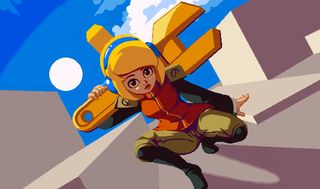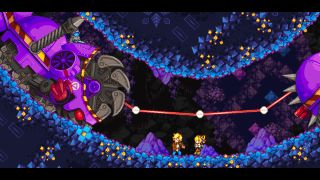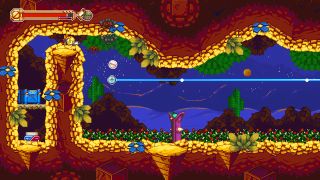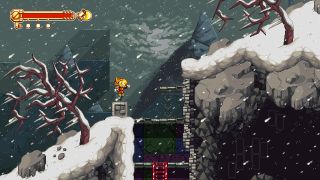The 10-year making of Iconoclasts
"I made the whole game just like I made games before: I make it as you play it. Which is not something you really should do if you want to have a view of your scope."

Joakim 'Konjak' Sandberg is not very health-conscious. For the past seven years, he's been developing Iconoclasts full-time completely on his own. It's been a heady mix of design, delays and, occasionally, depression, but Sandberg's masterwork will finally release on Tuesday, January 23. When I sit down to talk with him, he says he'll try to remember to take weekends off next time, and maybe he could stand to plan things out a little more. But looking back, he's proud of how far he's come on his own.
We first played Iconoclasts in 2013, two years before it hit Steam Greenlight bearing an optimistic 2016 release date. But Sandberg started working on it in earnest in 2010, and the original idea for it came three years earlier. With art inspired by Monster World 4—an old Mega Drive platformer which was re-released in 2007—and gameplay inspired by Metroid Fusion, it was the biggest idea Sandberg had ever taken on. Compared to his previous projects and experiments, Iconoclasts stands out because of its size alone, but also, he says, because of its ambitious story.
Iconoclasts is set in a world where everyone's jobs are decided by The One Concern, a sort of government overseer, Sandberg tells me. It's a world permeated by a fuel known as ivory, which is considered holy and used to power various machines. The mechanics who build and repair those holy machines command almost priest-like respect. So obviously you can't just decide to be a mechanic. That doesn't stop Robin, the main character and a so-called 'rogue mechanic', from doing just that after learning about machines from her father.

Robin's nest
"It is quite narrative-heavy," Sandberg says. "It's interesting, because I didn't have a script. I made the whole game just like I made games before: I make it as you play it. Which is not something you really should do if you want to have a view of your scope. You don't really know when it ends when you do that.
"At the beginning, the story is how I was thinking at the start of my 20s, and at the end it's how I was when I was reaching my 30s. It was always the intent that it starts very typical, very happy, sort of cliche, then turns into something darker. That's sort of how an adult mind shapes, I guess."
If you cut Iconoclasts in half, you could count the rings on it just like a tree. But rather than the game's age, you'd be measuring Sandberg's. He got into making games as a teenager through the development group Clickteam and, after a few years of tinkering with small ideas, started Iconoclasts in his early 20s. He's now heading into his early 30s, and that gap is reflected in Iconoclast's story.

"It is sort of a growing-up story, but not in terms of love, in terms of attitudes toward people," he says. "Robin is the center of that. She doesn't speak, so she doesn't have much more character than is implied from others and what you get a feel of from talking to other people and helping them.
Comic deals, prizes and latest news
Sign up to get the best content of the week, and great gaming deals, as picked by the editors.
"I'm a big fan of characters and I'm not a fan of lore. I want there to be character arcs. I go by feel when I write these things. Every single character is held back by something they want to be, but that they don't let themselves be because they feel the world wants them to be something else. Their conflict is being bitter about that and taking it out on each other. Robin, as the central character, succeeds and fails to get them to be more open about what they want.
If I don't finish this, I've thrown away five years.
Joakim Sandberg
"At the start of the game, Robin lives alone and all she wants to do is help people. She's the happy young person who thinks you can help anyone if you just believe. Across the game, she meets people who've lost the ambition to achieve what they want to do in their lives. In a way they're bringing her down, trying to convert her to their line of thinking. The point of those characters is that, for as long as she can, Robin stays positive."
Sandberg spent some of Iconoclast's development trying to stay positive and find motivation himself. For about six months around the end of 2014, he says it was hard to even work on the game. Finding his current publisher helped, but eventually, he says, it came down to "if I don't finish this, I've thrown away five years." Sticking to an art style he decided on almost 10 years ago was also challenging, he explains, as were the many factors that led to Iconoclast's long development.

Stuck in
"It's a big game with one person," Sandberg says. "Relative to other games, I actually think I was fast to do this with all the breaks and losing motivation from time to time. What takes all the time for me—and bosses are always involved to do too—is I decided early on to have animated cutscenes, which was hard to get motivation to do and took forever to do. Making gameplay, it feels like you're actually creating content. Making a cutscene, which takes longer to make than a level, feels counter-intuitive.
"And of course I went back and changed things. Stuff I wrote in the beginning was not stuff I wanted when I was 30. I mentioned I couldn't get a sense of scope. At the same time, if I wrote a script… It's not easy to write, but it's easy to write a lot. If I had a script before I made the game, I probably would have had something even bigger in scope, before I actually got a sense of how hard it would be to make. I think that's a benefit of making it up as I go."

Sandberg says some of his best ideas were born from his on-the-fly schedule. For example, Iconoclasts originally had much more complicated power-ups. But Sandberg didn't want it to feel bloated—he wanted players to have "just exactly what they need." So, he pared back the upgrades to emphasize finding the right strategy as opposed to stronger gear. That process ate up a solid chunk of 2017, a year Sandberg confesses he can scarcely remember.
Looking ahead, Sandberg expects he'll still be busy after Iconoclasts releases. He'll have plenty of post-launch maintenance to do, for one, and he already has an idea for his next game, which will be smaller in scope and different to Iconoclasts—something "I want to do rather than something I'm going to design to be successful," he says. But for now, as nearly a decade of helter-skelter development comes to a close, he's got just one thing on his mind: "I hope people enjoy it."
Iconoclasts will be available on Steam from January 23.

Austin freelanced for PC Gamer, Eurogamer, IGN, Sports Illustrated, and more while finishing his journalism degree, and has been a full-time writer at PC Gamer's sister publication GamesRadar+ since 2019. They've yet to realize that his position as a staff writer is just a cover-up for his career-spanning Destiny column, and he's kept the ruse going with a focus on news, the occasional feature, and as much Genshin Impact as he can get away with.
Most Popular




